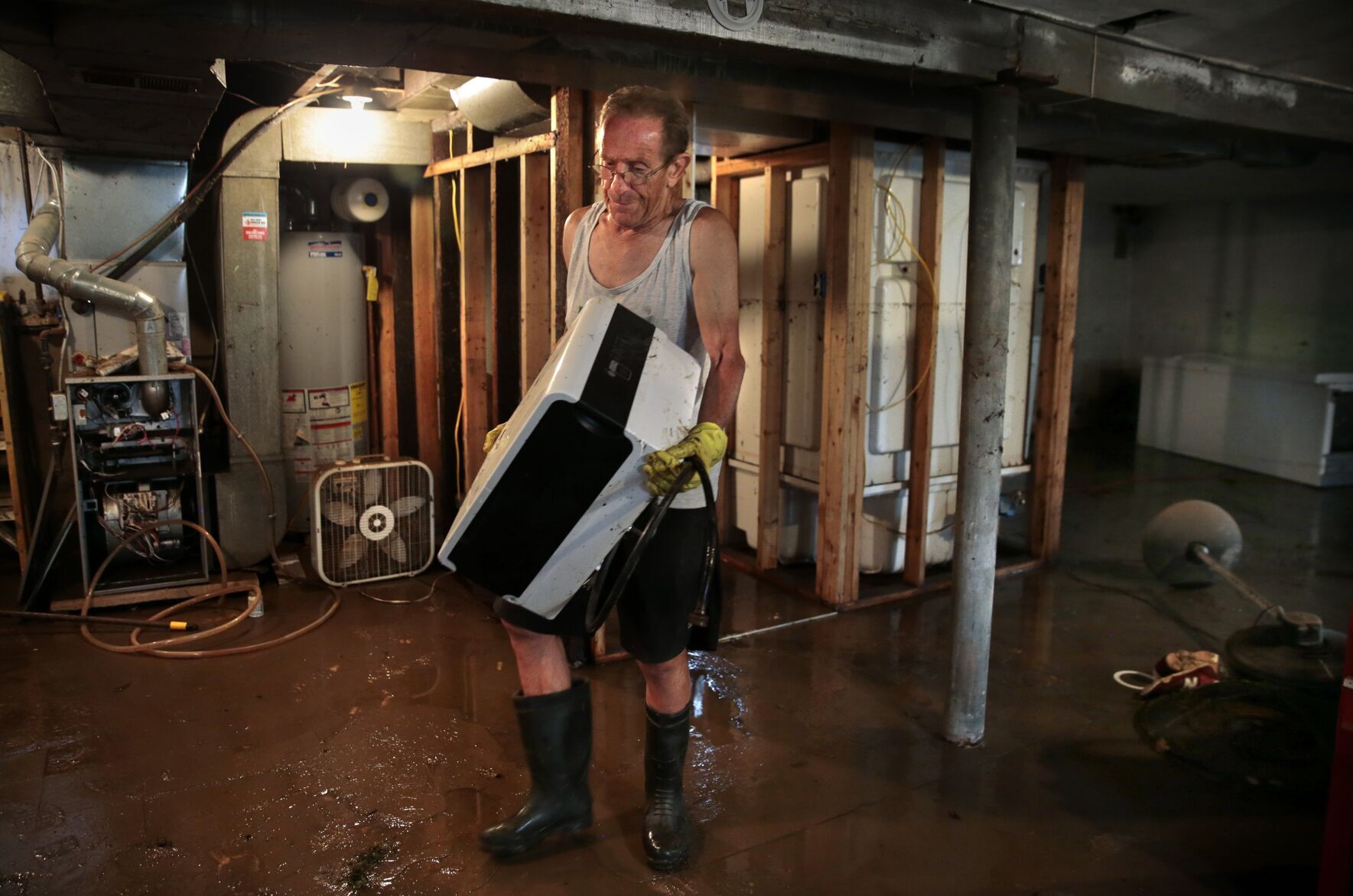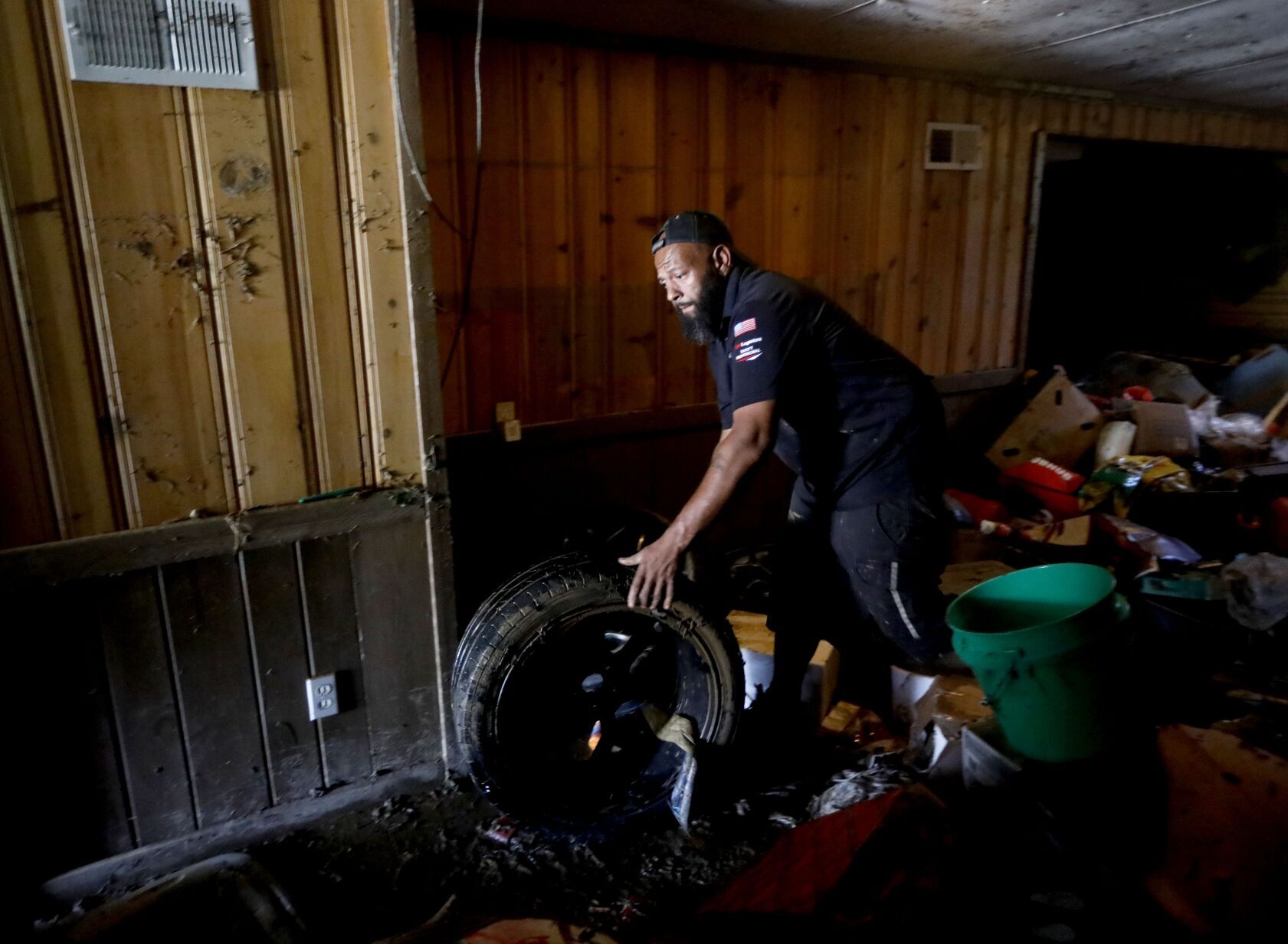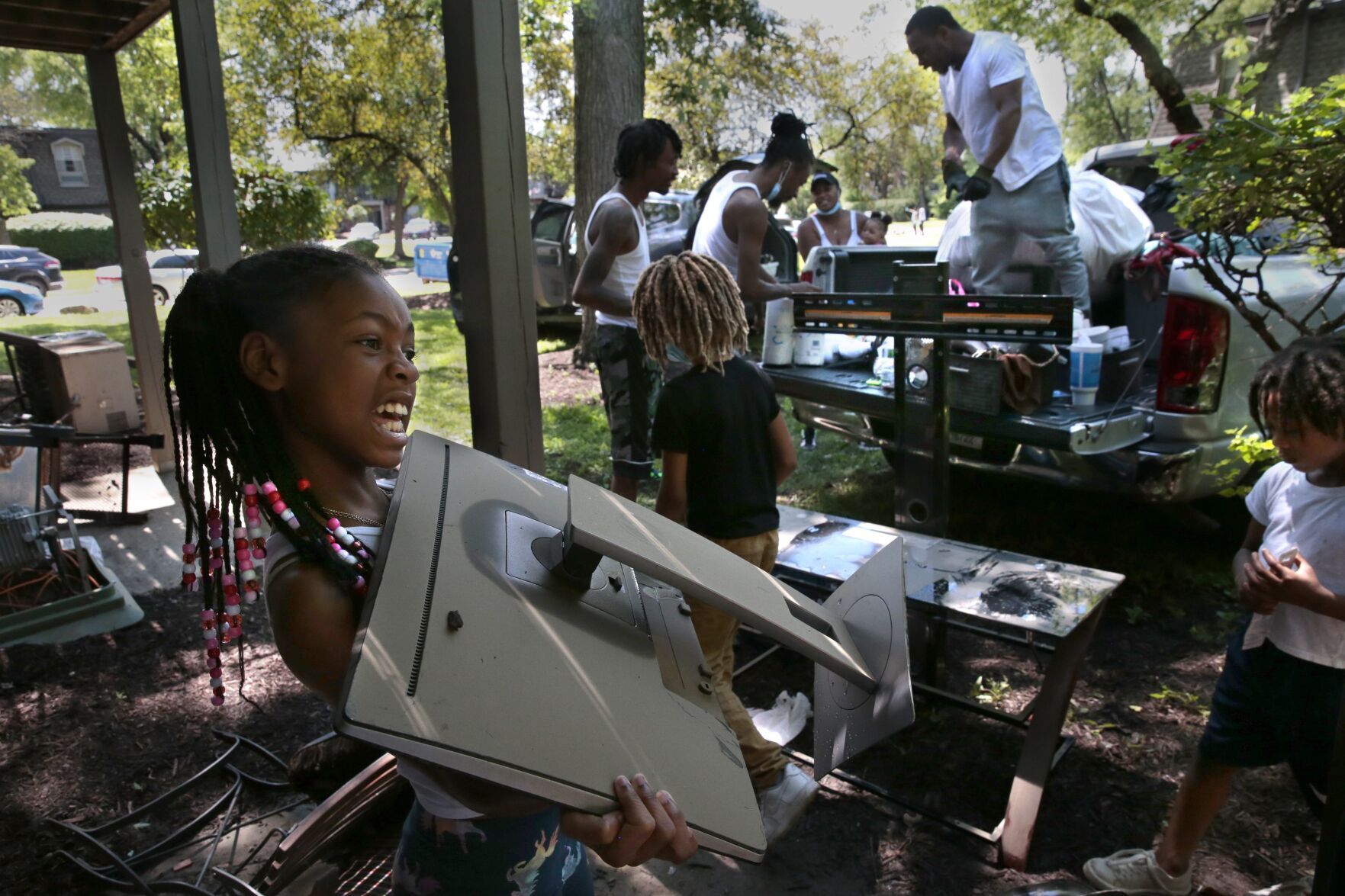St. Louis-area auto shops say most cars with flood damage cannot be fixed | Local Business
FLORISSANT — A blue Toyota Yaris landed at Danmark Tire & Auto this week. The driver had been on a bridge, trying to cross Coldwater Creek, when Tuesday’s rising water stopped its progress. A line on the car showed the water had reached about 4 feet up the side.
The shop owner, Richard Cox, looked at the car and shook his head. This one was totaled.
“I’ve always had bad experiences with cars that have been in a flood. All the wiring’s going to rust. Everything is going to rust in the car,” he said.
The case of the Yaris was especially sad, because the driver may also have been living in the car — the car was full of clothing and other items. Mud covered the floor, and the upholstery was still wet on Wednesday.
Hundreds of cars were swamped in the flash floods that hit the St. Louis area after a record-breaking rainfall Tuesday, and again after an intense shower on Thursday. They were some of the most poignant images from the week — water up to the windows, or higher. But after the water recedes, what then?
People are also reading…
A flood does not necessarily mean an automatic trip to the junkyard, said area auto repair shop owners. But cars and large amounts of water do not mix.
A handful of flooded vehicles were brought into Sparks Tire & Auto in St. Charles. The flooding was so severe that they were all totaled, including a medium-duty truck that had water almost up to the roof, said Greg Damon, company manager and host of the “KMOX Auto Show.”
Damon said that most vehicles will be free from damage only if water does not reach more than about halfway up the tire.
“When it gets a little higher than that, you’re going to start getting water into your passenger compartment. Most of the time, that can be cleaned and restored,” he said.
“When you get higher than that, it starts destroying electronics — underneath the dash, underneath the seats, in the heating and air conditioning, the computer, any number of things.”
At that point, he said, repairing the vehicle becomes costly. And if water gets into the engine or the fuel system, the engine will have to be rebuilt. In most cases, that would cost more than the car is worth.
Sometimes, people try to sell cars that have been flooded to unsuspecting customers. Danmark’s Cox said a good way to tell is if the carpet in the trunk shows a water line.
At Tactical Towing & Recovery in Belleville, Tuesday was an exhausting day. Calls came in so fast all day long that owner Brian Seiber said he could not make an outbound call.
“I’ve been towing for 18 years. I’ve never seen it that bad. The closest thing to this that I’ve ever seen is when we’ve had a really bad snow,” said Seiber, who estimated his crews went on 35 calls from 7:30 a.m. to 6 p.m. — and they had to turn down business because they did not have enough trucks and drivers.
After the tow drivers pulled cars out of the water, or at the repair shop after they had been towed there, the owners would try to start the car.
“As soon as it sputters and water comes out of the exhaust pipe, we say, ‘It’s time to call your insurance company. It’s totaled,’” Seiber said.
But Seiber said there are ways to improve your chances that your car will not be ruined if it goes into the water. If the driver turns off the engine before the water gets too high, then it has a chance of surviving the situation.
He said that about one out of every three or four cars that are turned off in floods can later start up and run.
But even if the vehicle can be driven, Sparks Tire & Auto’s Damon cautioned, that does not mean it will be unaffected by the water. Mold may grow, he said, and the wiring and the sensors underneath the dashboard may become corroded.
“It could be a few weeks, it could be a year” before the problems begin, he said.
Anyone whose car has been in water should have it checked out by a professional before driving it, he said.
Cox had better advice: “Don’t drive in any kind of water. You don’t know how fast it could rise.”


Photos: Flash flooding soaks residents twice in a week as cleanup begins
University City residents continue to clean up from flash fooding

“This year I quit paying my flood insurance. I had been pay $2500 a year since 2008,” said Timothy Grotrian, who cleans out his flooded basement on Friday, July 29, 2022, at his home along the 1200 block of Waldron Avenue in University City. Grotrian said his basement took in more than 5 ft of water during the first flash flooding on Tuesday. His basement flooded again yesterday during the heavy rains, flooding with more than 2 ft. of water. Photo by Laurie Skrivan, [email protected]
University City residents continue to clean up from flash fooding

Mia Henderson clears out carpet from flooded basement on Friday, July 29, 2022, along the 7000 block of Dartmouth Avenue in University City. More than a dozen of houses were flooded along the street from flash flooding Tuesday. Photo by Laurie Skrivan, [email protected]
University City residents continue to clean up from flash fooding

“I was sitting with my children on the edge of the couch and the water kept rising. It looked like we were on a cruise ship. I don’t swim,” said Patricia Saddler, who recalls how the water kept rising on the first floor of her house early Tuesday morning, as she salvaged clothing on Friday, July 29, 2022, at her home along the 1000 block of Wilson Avenue in University City. Saddler’s home has been condemned since Tuesday evening. Photo by Laurie Skrivan, [email protected]
University City residents continue to clean up from flash fooding

Brinkley Sandvall, who flew in from Texas to help clean up her brother’s flooded home, uses bleach water to clean toys on Friday, July 29, 2022, along the 1000 block of Wilson Street in University City. Photo by Laurie Skrivan, [email protected]
Double whammy in Ellendale as neighborhood floods twice in a week

Ernie Carr, 76, carries away a two-day-old dehumidifier brought by his grandson after Tuesday’s flood that was destroyed in Thursday’s second flood in Ellendale on Friday, July 29, 2022. Carr and his wife Nancy, who have lived in the neighborhood for 40 years, had just finished cleaning up more than six feet of water in their basement from the River des Peres Thursday morning when four more feet came, floating away their new purchase. Photo by Robert Cohen, [email protected]
Double whammy in Ellendale as neighborhood floods twice in a week

John Ward takes a moment to pet Vickie Barton’s dog Freya while emptying his wheelbarrow into a city-provided trash container in Ellendale on Friday, July 29, 2022. Thursday afternoon storms filled residents’ streets and basements with water from the River des Peres for the second time this week. “If they’d come with a good buyout offer, I’m gone,” said Ward, a 29 resident of Ellendale. Photo by Robert Cohen, [email protected]
Double whammy in Ellendale as neighborhood floods twice in a week

Ernie Carr, 76, takes a rest while his son-in-law washes down his basement that filled with Thursday’s floodwater from the River des Peres for the second time in a week in Ellendale on Friday, July 29, 2022. “Two times in a week, and it’s never happened,” said Carr, who has lived on Hermitage Avenue for 40 years. “So what did MSD do?” Photo by Robert Cohen, [email protected]
Double whammy in Ellendale as neighborhood floods twice in a week

Steve Gibson’s dog Ripper sniffs water soaked rags used to clean up Gibson’s classic car garage behind his Hermitage Avenue home in Ellendale after Thursday’s flood, the second in a week, on Friday, July 29, 2022. Gibson raised two cars in his garage, including his 1968 Plymouth Barracuda. Photo by Robert Cohen, [email protected]
Double whammy in Ellendale as neighborhood floods twice in a week

Mud-coated dolls sit in the backyard of the Hermitage Avenue home of Ernie and Nancy Carr following two floods of the River des Peres in Ellendale on Friday, July 29, 2022. Photo by Robert Cohen, [email protected]
Double whammy in Ellendale as neighborhood floods twice in a week

John Ward carts flooded contents of his Hermitage Avenue home to a city-provided trash container in Ellendale on Friday, July 29, 2022. Thursday afternoon storms filled residents’ streets and basements with water from the River des Peres for the second time this week. “If they’d come with a good buyout offer, I’m gone,” said Ward, a 29 resident of Ellendale. Photo by Robert Cohen, [email protected]
Double whammy in Ellendale as neighborhood floods twice in a week

Ernie Carr, 76, tosses away a lifetime of running bibs and numbers after his basement flooded twice in a week in Ellendale on Friday, July 29, 2022. Carr and his wife Nancy, who have lived in the neighborhood for 40 years, had just finished cleaning up more than six feet of water in their basement from the River des Peres Thursday morning when four more feet flowed inside that afternoon. Photo by Robert Cohen, [email protected]
Rescued by boats on Tuesday, apartment residents told to leave or risk losing their belongings by week’s end

Larry Ball carries artwork from his apartment in the Reserve at Winding Creek Apartments in Hazelwood on Friday, July 29, 2022. Residents, many who were rescued by boat from the flooded complex on Tuesday, scrambled for moving trucks when told they had to vacate the complex by the end of the day. Photo by Robert Cohen, [email protected]
Rescued by boats on Tuesday, apartment residents told to leave or risk losing their belongings by week’s end

A family member of Kenquita Hawkins peers from a truck as neighbors pack up and leave the Reserve at Winding Creek Apartments in Hazelwood on Friday, July 29, 2022. Residents, many who were rescued by boat from the flooded complex on Tuesday, scrambled for moving trucks when told they had to vacate the complex by the end of the day. Photo by Robert Cohen, [email protected]
Rescued by boats on Tuesday, apartment residents told to leave or risk losing their belongings by week’s end

“We lost everything,” said Keith Terry as he looks over his toppled refrigerator while cleaning out his apartment in the Reserve at Winding Creek Apartments in Hazelwood on Friday, July 29, 2022. Residents, many who were rescued by boat from the flooded complex on Tuesday, scrambled for moving trucks when told they had to vacate the complex by the end of the day on Friday. Photo by Robert Cohen, [email protected]
Rescued by boats on Tuesday, apartment residents told to leave or risk losing their belongings by week’s end

Kenquita Hawkins has a final look inside her unit before shutting the door after salvaging what she could from the Reserve at Winding Creek Apartments in Hazelwood on Friday, July 29, 2022. Residents, many who were rescued by boat from the flooded complex on Tuesday, scrambled for moving trucks when told they had to vacate the complex by the end of the day. Photo by Robert Cohen, [email protected]
University City residents continue to clean up from flash fooding

“This year I quit paying my flood insurance. I had been pay $2500 a year since 2008,” said Timothy Grotrian, who cleans out his flooded basement on Friday, July 29, 2022, at his home along the 1200 block of Waldron Avenue in University City. Grotrian said his basement took in more than 5 ft of water during the first flash flooding on Tuesday. His basement flooded again yesterday during the heavy rains, flooding with more than 2 ft. of water. Photo by Laurie Skrivan, [email protected]
University City residents continue to clean up from flash fooding

“I am just digging through a lifetime of memories…. water always wins,” said Ty Treutelaar, who clears out items in his flooded basement on Friday, July 29, 2022, along the 1100 block of Birch Lane in University City.
University City residents continue to clean up from flash fooding

“These tires used to be in the garage,” said Anthony Saddler, who cleared items from his flooded basement on Friday, July 29, 2022, on Wilson Avenue in University City. Saddler said his home has been condemned since Tuesday evening.
Rescued by boats on Tuesday, apartment residents told to leave or risk losing their belongings by week’s end

A resident of The Reserve at Winding Creek apartments in Hazelwood dons a mask before entering her building to clean out her unit on Friday, July 29, 2022.
Rescued by boats on Tuesday, apartment residents told to leave or risk losing their belongings by week’s end

Kasey Hawkins, 10, joins family members helping her aunt Kenquita Hawkins move from her apartment in The Reserve at Winding Creek apartments in Hazelwood on Friday, July 29, 2022. Residents scrambled for moving trucks when told they had to vacate the complex by the end of the day.
University City residents continue to clean up from flash fooding

“I am just exhausted. I am waiting to hear back from cleaning services and insurance companies,” said Jamal Walls, who takes a moment to breathe, from clearing out items from his flooded basement on Friday, July 29, 2022, in the 7000 block of Dartmouth Avenue in University City.
Double whammy in Ellendale as neighborhood floods twice in a week

Ernie Carr, 76, carries away a two-day-old dehumidifier after Tuesday’s flood that was destroyed in Thursday’s second flood in Ellendale on Friday, July 29, 2022. Carr and his wife Nancy, who have lived in the neighborhood for 40 years, had just finished cleaning up more than six feet of water in their basement from the River des Peres Thursday morning.























